Full disclosure: ham radio isn’t for everyone, and there are many different facets to it. What appeals to one person might bore another to death. One area of ham radio that has changed a lot in the last few years is more or less local and typically mobile operation on VHF or UHF. Not long ago, hams used HTs (walky-talkies or handi-talkies) or mobile radios via repeaters to talk to each other and — the golden prize back then — make phone calls from their cars. Cell phones have made that much less interesting, but there is still an active community of operators talking on repeaters. However, the traffic has gone digital, the Internet is involved, and people with inexpensive, low-powered radios can talk to each other across the globe. This is nothing new, of course. However, having digital services means that operators with special interests can congregate in what amounts to radio chat rooms organized by region or topic.
There’s a long history of people listening to ham radio conversations with shortwave radios, SDRs, and scanners. But with so much activity now carried on the Internet, you can listen in using nothing more than your web browser or a phone app. I’ll show you how. If you get interested enough, it is easy enough to get your license. You don’t need any Morse code anymore, and a simple Technician class license in the United States is all you need to get going.
A Quick DMR Primer
There are several digital ham networks around and like real networks, you can have different physical transport layers and then build on top of that. For the purposes of this post, I’m going to focus on DMR (digital mobile radio) on the Brandmeister network which is very large and popular ham network. You won’t need a license nor will you need to sign up for anything as long as you are content to just listen.
Here’s how it works: Brandmeister operates a large number of servers worldwide that communicate with each other and provide calling services, including group calls. So, if we set up a Hackaday talk group (fictitious, by the way) on group 1337, interested people could connect to that talk group and have a conversation.
Since we are just going to listen, I’m going to skip some of the details, but the trick is how people get to talk to these networks. In general, there are three ways. The classic way is to use a digital radio to talk to a repeater that is connected to the network. The repeater may have one or more talk groups on all the time, or you might request access to one.
However, another way to connect your radio to a “hotspot” connected to the Internet. That is, more or less, a special form of repeater that is very low power, and you have complete control over it compared to a repeater on some faraway hill. However, if you don’t mind operating using just a computer, you don’t need a radio at all. You simply talk directly to the nearest server, and you are on the network. Some of your audio will go to other computers, and it may go over the airwaves via someone else’s hotspot or repeater.
Talk Groups
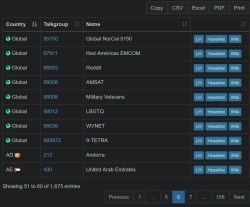
The Brandmeister website has a lot of info and you don’t need to be logged in to see it. Head over to their site and you’ll see a lot of info including a network map and statistics about repeaters and hotspots. You can get an idea of who has been talking lately by clicking Last Heard link. While this is interesting, it isn’t as interesting as you’d think, because you really want to focus on talk groups, not individual users.
To see a list of all the talk groups on the system, you can click Information and then Talkgroups. You can filter the list and you can also download the dataset in different formats if you want to browse it in a different format.
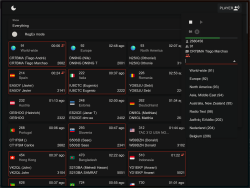
There are three buttons on each row of the database. The LH button shows you the last heard stations for that group. The Wiki button takes you to a Wiki page that, for some groups, has more information about it. But the really interesting button is the one marked Hoseline. You can also open the Hoseline directly which is what I usually do.
What’s the Hoseline? It shows activity across the network as a bunch of boxes indicating recently active talk groups. Boxes with red lines around them have people actively talking on them. The others have been recently active. It is visually interesting, yes, but that’s not the big selling point.
If you click on a box, you will hear the activity on that talk group. That’s all there is to it.
Overwhelming
There are a lot of talk groups. You can filter at the top left part of the page where it says “Everything.” You’ll have to drop the list down and unselect Everything. Then, you can select any countries or areas you want to follow. If you are brave, you can click RegEx mode and enter regular expressions to match talk group numbers (e.g. ^310.*).
The “Player” button at the top right gives you more control. You can add multiple groups from a list, see information about who is talking, and stop or start the audio.
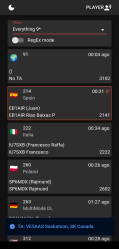
If you prefer to do your listening mobile, you can also get the hoseline on your Android device. Just install the app, and you’ll find it works the same way.
Finding Something Interesting
Lord Nelson once said, “The greatest difficulty in war is not to win the battle, but to find the enemy.” That’s accurate here, too. Finding an interesting conversation out of all those talk groups is somewhat a needle in a haystack. A quick look around at the talk group lists might help.
The 91 and 93 groups stay busy but generally with short exchanges since they cover a wide area. The USA bridge at 3100 sometimes has traffic, too.
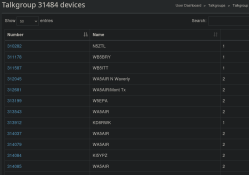
If you look at the group’s listing on the Web, you can click the group number and see what stations are connected to it. Keep in mind, some of these may be repeaters or gateways that could have no one on the other side, or could have dozens of people on the other side. But it can give you an idea if the talkgroup has any users at all.
You can also search the Internet for DMR nets and repeaters. Sometimes, it is interesting to listen to local repeaters. Sometimes, it is fun to listen to repeaters in other places. Want to find out what’s going on at your next vacation spot? Practice your French?
You can find many DMR repeaters using the RepeaterBook search page. There are also man lists of DMR nets.
Next Steps
There are many other similar networks, but they may not have a way to listen that doesn’t require some software, registration, or licenses. There’s plenty on Brandmeister to keep you busy. If you worry about people listening in, that’s no different than regular radio has been since the beginning.
You can always get your ham license and join in. Even without a radio, there are ways to talk on the network. [Dan Maloney] has advice for getting your “ticket.” It is easier than you think, and you can do a lot more with a license, including talking through satellites, sending TV signals over the air, and bouncing signals of meteors or the moon. If you want to listen to more traditional ham radio in your browser, try a Web-based SDR.

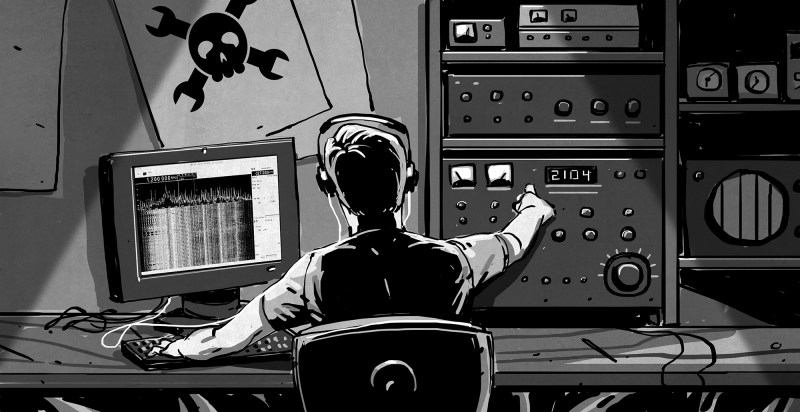














I don’t know in other countries, but in France, if you have no HAM licence, you can also buy HAM tranceiver to listen all bands (HAM or other), or use scanner all frequency. This is a goof thing.
I don’t see anything wrong in that. The HAM license ensures the regulated use of a scarce resource, that is, the radio spectrum. If you don’t transmit you’re not using the spectrum.
Regarding government secret transmissions, well, they’re all encrypted today, and having a HAM license didn’t automatically allow people to intercept them.
Moreover, forbidding people to buy transmitters would only make things worse as building one is not that complicated, and we would end up with pirates using homemade stuff that either sweeps in frequency, or it’s overloaded, and without or with sub par output filters instead of properly tested gear.
In Spain telecom ministry doesn’t police HAM frequencies anymore since a few years ago, if you don’t fu** in commercial frequencies, they give no importance. The URE (biggest ham radio association and ham radio lobbying force) did an excellent job gatekeeping the hobby. They moved earth and sky to keep Citizen Band under license until 2008 or so. Because they feel having an official ECB-xxxx call sign was “necessary” and “cool”. Now the hobby is almost dead.
Oh come on, Spain! 🙄
I’ve heard negative things about Spain in the news in the past years, especially in the Euro crisis.
I read that 2008 was worst year, maybe that’s why the ministry gave up?
Does Spain have some functional gov institutions, at all, anymore?
I heard that a quite some private companies do provide services now and that it suffers from forms of corruption.
So it’s not exactly a role model, maybe, I mean. Speaking under correction, of course.
Oh, and CB call signs are not new.
The Americans had them up until late 70s or so, while in my country it was a thing up until late 80s.
CB Packet Radio call signs were freshly issued in my country in the mid-90s, also.
Up until early 2000s, official CB Packet Radio call signs could be requested from telecom ministry here.
Then they gave up and made it “pick yourself”, but kept recommending to keep the existing scheme.
The biggest CB club then worked together with ministry in issuing newer CB PR call signs.
You could send in a photocopy of your ID card, fill out a forms and pay a small fee (about 10€).
Then you would get your CB ID card via mail, while your personal information would be shared with the ministry.
Card looked like this (example website, first two pics): https://tinyurl.com/6k7wx572
^These CB call signs were also used as operator names, just like in ham radio.
The use of these call signs was intended for Packet-Radio use, but not restricted to it.
To a radio amateur, this whole procedure was just logical and normal.
Of course, such a call sign could be used to track you back. That’s the whole point.
PS: DX clubs for CB radio stilli issue call signs for CB radio.
Because in international QSOs on CB band, you can’t use a handle/skip to identify yourself.
Identifying as “Rubber Duck” or “Mickey Mouse 123” is nonsensical.
You rather have proper call signs like 13CTxxx or 13RFxxx in my country. Just like in amateur radio.
In the US it is legal to buy a transceiver without a license, but of course, it is illegal to transmit without a license.
WebSDR also allows you to do things like decode NOAA APT (just about with manual Doppler adjustment to get more than a thin slice), WEFAX, NAVTEX.
CB radio is still unlicensed in some places so no tests required. And most of the people on HaD could probably pass the foundation level exam for a license in the UK without revision.
It’s OFCOM or FCC or other state level regulatory body you register with, that’s to make sure you don’t do anything illegal/unlawful/damaging, you’re being ghosted for not having a licence because it is unlawful for them to talk to you.
Using a call sign and getting a licence is the price of being allowed to transmit legally, doubly so if you are using someone else’s infrastructure such as a repeater or server network as they have a legal responsibility to do their best to only allow licensed people to use their kit and not cause interference to others.
Realistically though, if you want to chat to your local friends with a HT on a simplex channel, I doubt anyone will bother trying to hard to find you for enforcement purposes, unless you’re causing interference to people who aren’t hams.
In defense of ‘But regulations-‘ Hams have a long LONG history of having to fight to keep the frequencies they have under fear of ‘you’re not using it well. We’re giving it to someone less unruly/actually making us money.’
The scars from the US Navy trying to strangle Amateur Radio in its crib runs deep.
Begging for rights is lame. Grant them to yourself with your own power.
So.. The moral of the story is that stealing is better than “paying” (obtaining something rightfully) ? 🤨
Take me out to the black,
Tell them I ain’t comin back.
Burn the land and boil the sea,
You can’t take the sky from me.
The moral of the story is that you are the author of your own rights, so long as you have the power to enforce them. You do not need to ask anyone permission to do this.
I love how American Libertarians are easily identifiable by their utter hatred for all regulation without any consideration whatsoever for why those regulations exist.
You are the very textbook definition of antisocial.
I do have to say that in the UK at least the kind of busy bodying you see in hobbies is strongly frowned upon.
The Victor Meldrew types.
After all, I carry a pen knife but I don’t go about town frisking people for illegal knives personally.
You get them everywhere, golf courses, allotments, “real ale” pubs.
To be pretty blunt? The regulations generally aren’t all that much of a bother on this one. I happen to agree why they exist for the most part (largely to prevent interference with other users of the spectrum and to make it easier for people using the air waves to find what they’re looking for.)
Would i like more bandwidth? Sure, but I’d also be a massive toolbag for doing so.
This is using a public resource. If this were ‘showing up and protesting a HOA by way of creative disobedience’ I’d be all for it because HOAs are garbage.
Amateur radio is about self-policing, always has been.
And it has nothing to do about elitism or obedyence.
It’s about the willingness to co-exist in a friendly and helpful manner, by playing fair by rules.
In sports, rules do matter, too and cheaters are being punished.
The “ham spirit” in the form as defined by Paul M. Segal in 1928 gives a good understanding, I think.
It’s not about the license so much, but about being a ham by heart.
https://www.arrl.org/amateur-code
In early days and in times of war, some hams also operated unlicensed as radio pirates.
But they never abused the frequency spectrum and got a legit license once being able to.
Still, there had been hams who had humor and were “sassy”.
Young radio amateurs in say, the 70s/80s, did occasional play fun on others.
Like having a transmitter w/ linear in the back of the car and another ham standing by the car holding a bare fluorescent tube that did light up for no apparent reason to the pedestrians walking by.
In this respect, they were not much different to CBers who played some harmless tricks on society.
Secondly, radio amateurs have the right to track down intruders of their band in order to defend it.
They can tri-angulate an intruder by directional finding, for example.
Back in the good old days (70s, 80s), the whole club set out to catch an illegal transmitter (sometimes a CBer or ham).
Like a pack of wolves, if ypu will. However, they respected law and usually acted diplomatic.
They were friendly to the intruder and tried to make him understand that he’s violating law.
If he didn’t comply, they had the right to inform the authorities, of course.
That’s how it used to be my country, at least.
Anyway, that’s not strictly exclusive to amateur radio.
Try invading other services, such as police radio, ambulance radio, air radio or military radio and see what happens.
These guys are not as nice as hams are when knocking on the door, maybe.
What also could be mentioned here is EchoLink, maybe.
It allows connecting to distant FM repeaters over internet.
Yes, it looks a bit unsporting at first because it involves internet but it sometimes makes sense.
For example, it allows a traveling ham to make contact to his/her hometown FM repeater and participate with his/her community.
Another application is to visit a distant FM repeater through EchoLink and being able to talk to the hams living there.
That’s useful for inviting a guest ham from a far away land, too.
https://en.wikipedia.org/wiki/EchoLink
The KiwiSDR android app is interesting too, there are loads of HF recievers online around the world, and it demodulates some modes like SSTV and Fax within the app.
EchoLink requires a license to be able to use it, the focus of this article is what can be done without a license…
Absolutely agree. Ham radio will fade out of existence if it fails to provide something the internet can’t: anonymous point-to-point communication. Let me talk without doxxing myself. Let me play music over the radio. Let me say offensive words. Let me encrypt my messages. Regulations are keeping ham radio in the dark ages.
“But what about bad people using the radio for bad things?”
I don’t care? Literally not my problem. Not worth losing my freedom for, in any case.
Well no government it going to let anyone use it for that, but if you’re going to operate illegally anyway, what do you care what the government thinks?
Dude, that stuff is nothing that I would associate with amateur radio in first place.
That’s consumer stuff, anti-social behavior.
CB radio and GMRS (or how this US thing is being called) is better suited for this, I’m afraid.
Amateur radio is about science, fascination about radio technology and is history,
tinkering with electronics, independent infrastructure (Packet-Radio, APRS, HamNet etc) and international friendship.
Amateur radio is what can be used in space, to eventually communicate with colonies on moon or mars.
It’s much more mature than just being a playing field for the paranoid,
those preppers hiding in their atomic shelters
and the ones which watched one or two episodes of The X-Files too much. ;)
Heck, the first hams were real gentlemen in suits with ties!
And now there are you folks who demand that amateur radio should be turned
in a post-apocalyptic something were anarchy rules,
were people send warez, pr0ns and propaganda messages via encrypted transmissions. On the ham bands. Great! 😮💨
Turns out being civilized is kind of boring.
Why are you here, then? Go be antisocial by yourself.
Who’s problem is it when you can’t use your radio because a bunch of other people with your priorities stomp all over your Comms and,because of your lobbying, nobody polices it?
If nobody can communicate, eventually everyone will quiet down. Same as talking in a crowded room. You obviously didn’t think this through.
You’ve obviously never been in a crowded room. Nobody quiets down. They all just talk louder to be heard over the noise – making the noise worse.
You’ve rolled a bunch of stuff into a ball here, so let me take it a piece at a time…
“Ham radio will fade out of existence…”
This remains to be seen (I am a VE, by the way, so I’m actively involved in adding new brothers/sisters to the fold. I am pleasantly surprised at how many people attend our test sessions. Youngest, so far, was a 9-year-old-boy. The oldest? an 85 year old lady. Both passed their Tech.)
“…if it fails to provide something the internet can’t…”
Ham radio already provides something the internet can’t–communications without infrastructure.
I wonder how good cell service is in the middle of those California fires. How about internet connectivity there? When the twin towers went down during “9/11,” the loss of the antennas on those structures (not to mention the underground infrastructure damage that occurred when the towers fell) knocked out a LOT of comms. The point is, comm infrastructure can disappear in a moment.
On the other hand, I have alligator-clipped a QRP ham transmitter to a metal flag pole and worked operators several states away. No flagpole? A wire tossed in a tree will do.
“Regulations are keeping ham radio in the dark ages.”
There is some truth to that, particularly when new ways of encoding signals are introduced.
“Let me say offensive words.”
This, I don’t understand. What value does that capability add? You can’t get enough of that garbage in virtually EVERY other electronic medium? Seriously, how hard is it to be civil during a conversation with a stranger? This isn’t a first-amendment issue, by the way… there is no fact, opinion, or political discontent you can’t articulate without having to resort to gutter-speak.
“Let me encrypt my messages. ”
That’s an idea I could support, provided that your transmission was either prefaced or suffixed with an unencrypted call sign.
“Let me talk without doxxing myself.”
Fundamentally, I don’t oppose the idea of anonymous point-to-point communication. But why do you insist that ham regulation embrace this when anonymity is really not a feature of any other comm option? If you have a street address, a cell number, or an IP and a MAC address, you aren’t anonymous… not really.
While I think the desire for anonymity (I read this as “privacy”) is legitimate, my concern is that anonymity in the ham bands would gut the notion of self-regulation. I CARE about my reputation on the air and in the ham community, and most other hams do, too. Unfortunately, a certain portion of any group are happy to turd in the punch bowl so long as nobody sees them do it. I think anonymity in the ham bands would quickly reduce them to CB channels.
“Let me play music over the radio. ”
Why do you need to do that on the ham bands? That’s not point-to-point communication. That’s broadcasting.
That said, I would like to see the law regulating FM broadcast stations changed to allow for the easy/cheap licensing of small, low-power, FM transmitters… think of it as a “public access” channels on the airwaves.
Exactly this … all of it. You clearly have several IQ points advantage over Anonymous.
lol
Oi mate! You need a loicense to make a claim like that.
Getting on the air for broadcast FM was as easy as me walking into the local public access station when I was in college and asking for a slot. Admittedly I did have to learn to use the “trainer station” for a few months that only broadcast AM like 15 feet and make a demo tape, but after that I was given keys to the studio and rocked the airwaves for three years. It was a wonderful station.
Dude, first of all, that’s not what HAM radio is about and second, you sir, are a clueless fool.
You can’t have anonymity on radio because, surprise, physics. Anyone with an antenna can track your transmitter down, given enough time and resources. If you want to see a demonstration first hand, try to interfere with something important. E.g. airband (just above the FM broadcast band) is a very good candidate if you want a rapid attention of authorities.
And second, maybe consider that those regulations you despise are what keeps e.g. the law enforcement, fire & rescue radios working. Together with air traffic control, satellites that deliver your TV, your internet and phone service. Oh and also your cell networks.
Make it a free for all and the interference will kill all of that. Which is happening already – if you thought the congested unusable wifi is bad, just wait if your cell service or satnav were jammed or interfered with.
Those regulations exist worldwide in a mostly compatible and coordinated manner for very good reasons – physics doesn’t care about your ideology or national borders.
Thing is, I think I might enjoy HAM radio ,,, but I have to many hobbies already. Between programming, electronic projects, R/C aircraft building/flying, and firearm shooting/reloading… and living :) . Doesn’t leave much room for anything else. I’ll let someone else enjoy the hobby and I’ll just enjoy reading about it :) .
The cool thing about ham radio is that it involves many of those hobbies you listed. You can practice and apply those skills with ham projects. It is considered the king of all hobbies for a reason. No one is capable of doing everything ham radio has to offer in one lifetime.
It’s also a great way to meet people interested in your other hobbies too.
Come on, join us! One of us. One of us. :)
Are you… me? Tyler Durden style?
I do that with model railroading. A bunch of dedicated railfans take care of that hobby quite well, and every three or four decades I take a peek at someone’s layout. Every few months I see some good video of a 12-inches-per-foot operation and once in a great while I’ll visit some restored steam railway. Maybe one day I’ll restore my ham ticket.
You check in every 30-40 years? Are you a vampire?
What’s the best radio service for emergency use while traveling in areas without cell coverage? CB because it’s users are more likely to pass by and relay your message at some point or ham where users are less likely to pass by. Also assume that there are no ham repeaters within range.
Starlink – assuming you’re in a car. It’s trivial to get on Facebook or Skype and ask your relatives to call for help. Or Iridium phone if you’re going on foot.
Q-100 satellite is always within range depending were you live.
As a famous example, The Von Neumeyer Station III in the antartic has an QO-100 station, too, among other radio equipment.
https://www.awi.de/en/fleet-stations/stations/neumayer-station-iii.html
https://marsonearthproject.org/neumayer-station-iii-interview/
To reach Q-100, a portable 50cm sat dish and a transceiver (+ converter) is all it needs at the minimum.
https://en.wikipedia.org/wiki/Es%27hail_2
Thanks for sharing this; I was not aware of it!
I just wish there were a couple more of them for global coverage.
Thanks, but I should have made it clear that the two choices are CB or ham radio for now. Use of a Q-100 geostationary satellite station is not practical for the hopefully very rare need to use it when traveling by car and Starlink’s direct to phone service isn’t much of a thing yet.
This is why the Wouff Hong exists.
If you feel this way, you may be interested in the anarchist radio relay league.
So you can’t pass a ham test then I take it? Grow up. A ham recently got a $34,000 fine by the way for using frequencies he wasn’t supposed to.
Worth noting that guy was mis-directing fire rescue planes. Incredibly irresponsible behavior, and that fine strikes me as a little light given the impact it could have had.
It is not an acronym. It is just “ham”. Oh, and Hoseline is nifty.
Hey, 10 meter is open enough I can use the FM transceiver in my car!
Aaaannnnd there’s some guy broadcasting his preaching on 29.6.
Hey, there’s actually someone on the 2-meter calling frequency!
Aaaaannnnd they are having a conversation about their Trumpy stuff, about as enlightened as a tungsten rod.
I’ve had my license long enough to renew it a few times already buy my interest in actually talking to anyone is waning.
No kidding. In college I would help the lab manager run his office in exchange for access to equipment. His office held the university’s repeater and I’d spend hours listening to it since it was connected to a speaker.
Most of the conversations were old men talking about how things were better before the Civil Rights movement. I’ll never forget the time these geezers were talking about how Obama was going to have them executed for being Christians any day now, and one of them commented that the FCC would probably report their conversation to him. For security, they switched to Morse code for the rest of their chat.
I’ve got a license, I’ve got a few radios and a big antenna. I simply haven’t found anyone on the radio worth the effort to talk to.
Well, regulation does have its good points and some negative. There a few “Sad Hams” who seem to think that they are the regulators….
I’d love the ham bands to be deregulated.
I have a few transceivers, a large antenna, and a couple boxes designed for bridging Wi-Fi over voice radio in short-range industrial applications. I could have live Internet in my car at all times if the hams weren’t using it to discuss their medications and how the weather is. If the government would just get out of the way we could be using those frequencies for something useful!
Well, I do have a Kenwood TS-430 but no antenna so i haven’t been on HF in a while.
I’m not one of those contesters who are on the air 24/7 , but I did do Worked All States on one net
and one frequency. Since I’m in senior living now, I do take the 430 up to the roof garden on Field Day to have some fun. There’s always someone to talk to. I like trains myself, and have done the cross country Amtrak trip. Very nice. If you don’t like what you hear, spin the dial until you find something you do.